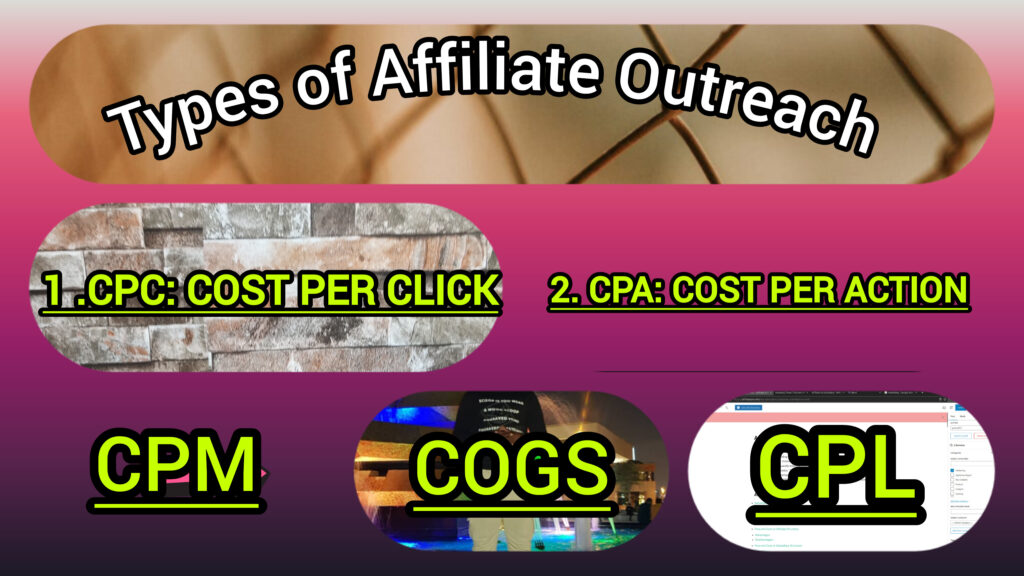Speed in the purchasing process is an advantage of affiliate marketing. This is because it is much easier to sell products online than in a physical store for many reasons.
One of these factors is the variation in payment methods, which makes purchasing easier for customers who cannot travel to make the purchase.
Furthermore, the great advantage is that the dissemination of affiliate marketing happens precisely where the public is.
For example, if an affiliate chooses to promote a product such as a cooking course, they can use a blog or a YouTube channel that talks about gastronomy.
Anyway, if there is a good performance between producer and affiliate, this is a strategy that can be very successful and it is worth investing in this trend.
Types of Affiliate Outreach
As I said above, affiliate marketing is not just focused on products and services.
The strategy also works well for acquiring leads and other types of actions.
In this type of promotion, the affiliate is rewarded according to the number of leads he obtains for the producer.
This can be done through clicks, actions, leads, thousand impressions, form or sales.
The producer decides which of these subsidies are most suitable for their products and strategy objectives.

I’m going to talk about some of these types of disclosure. Check out.
CPC: Cost per Click
Remuneration happens per click, that is, you are paid whenever someone clicks on the banner, pop-up, or any advertising displayed on your blog, website or social networks.
In this case, the affiliate’s remuneration will directly depend on the performance of the advertiser’s campaign in their space.
CPA: Cost per Action
The affiliate is remunerated when users click on the advertisement and perform actions on the ad’s landing page.
These actions can be registrations, quote requests, downloading an eBook, signing up for a webinar or making a purchase.
However, in these cases, it is not enough to run advertising, the affiliate will have to use their influence to talk about the product and convince their audience that the offer is reliable.
In other words, if this is the chosen model, it is essential to pay attention to the CTA (call to action).
CPM: Cost per thousand impressions
In this case, the producer or advertiser pays the affiliate a fixed amount, which he receives when the advertising banner manages to reach a thousand views.
Whenever a user accesses your blog, it generates a page view and, consequently, an impression of the advertising banner.
Therefore, the number of impressions is equivalent to the number of page views of the blog, assuming that whoever browses a page is already being impacted by the advertising there.
This, of course, if you consider that the banners are in privileged positions on all pages, so that all visits automatically generate views.
Then the cost per thousand impressions ends up being a much more interesting option for affiliates who tend to have a lot of recurring visits to their page.
Because this way he always gets paid, without having to depend on how many visitors click on the banner.
COGS: Cost per Sale
Cost per sale is the best option for small entrepreneurs.
In this case, you only invest your money when, in fact, the affiliate generates sales for your company.
The measurement of the amount of sales is done through the partnership, differentiated links are generated by the platform for each of the affiliates.
This allows commissions to be calculated and processed automatically at the time of purchase.
So, just choose the option that makes the most sense for you and your digital marketing strategy.
Regardless of the strategy or commission model chosen, it is important that the parties establish a relationship where all conditions are really clear.
CPL: Cost per valid Lead
Validating leads isCPL: Cost per valid Lead the key to this stage of affiliate marketing.
The affiliate’s role is to awaken the public’s interest in the product or service.
This is because, in addition to filling out a form and providing your data and email, for example, the person needs to confirm this registration.
A great alternative for those whose main objective is to have warmer leads for their business.
Cost per Form
The affiliate’s objective is to attract the visitor and make him sign up on a certain form, whether simple or complex.
Through this type of advertising, the producer gets more people on their registration list and the affiliate wins regardless of whether or not the user in question becomes a customer of the company. If the form is completed, the affiliate is already remunerated.
Read More: Affiliate vs Subsidiary: Understanding the Differences


